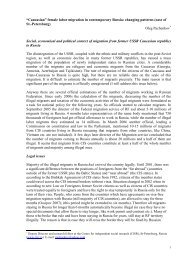THORIUM AS AN ENERGY SOURCE - Opportunities for Norway ...
THORIUM AS AN ENERGY SOURCE - Opportunities for Norway ...
THORIUM AS AN ENERGY SOURCE - Opportunities for Norway ...
Create successful ePaper yourself
Turn your PDF publications into a flip-book with our unique Google optimized e-Paper software.
5.4.2 Generation IV Reactors<br />
Nuclear Reactors <strong>for</strong> Thorium<br />
Launched in 2000 by the US, the Generation IV initiative is a collaborative ef<strong>for</strong>t of the world's<br />
leading nuclear technology nations to develop the next generation nuclear energy systems to meet<br />
the world's future energy needs. The GIF members, gathered within the Generation IV<br />
International Forum (GIF) chartered in 2001, defined the eight following goals <strong>for</strong> these systems<br />
in four key areas; sustainability, economics, safety and reliability, proliferation resistance and<br />
physical protection:<br />
1. Sustainability-1: Generation IV nuclear energy systems will provide sustainable energy<br />
generation that meets clean air objectives and provides long-term availability of systems and<br />
effective fuel utilization <strong>for</strong> worldwide energy production.<br />
2. Sustainability-2: Generation IV nuclear energy systems will minimize and manage their<br />
nuclear waste and notably reduce the long-term stewardship burden, thereby improving<br />
protection <strong>for</strong> the public health and the environment.<br />
3. Economics-1: Generation IV nuclear energy systems will have a clear life-cycle cost advantage<br />
over other energy sources.<br />
4. Economics-2: Generation IV nuclear energy systems will have a level of financial risk<br />
comparable to other energy projects.<br />
5. Safety and Reliability-1: Generation IV nuclear energy systems operations will excel in safety<br />
and reliability.<br />
6. Safety and Reliability-2: Generation IV nuclear systems will have a very low likelihood and<br />
degree of reactor core damage.<br />
7. Safety and Reliability-3: Generation IV nuclear energy systems will eliminate the need <strong>for</strong><br />
offsite emergency response.<br />
8. Proliferation Resistance and Physical Protection: Generation IV nuclear energy systems<br />
will increase the assurance that they are very unattractive and the least desirable route <strong>for</strong><br />
diversion or theft of weapons-usable materials, and provide increased physical protection<br />
against acts of terrorism.<br />
In 2002, the GIF selected the six most promising systems that offer advantages in the four key<br />
areas and could be deployed commercially by 2030 [5].<br />
Nowadays, the GIF has the following 13 members: Argentina, Brazil, Canada, China, Euratom,<br />
France, Japan, Republic of Korea, the Russian Federation, Republic of South Africa, Switzerland,<br />
the United Kingdom, and the United States. Currently eight Members are Parties to the<br />
Intergovernmental Framework Agreement <strong>for</strong> International Collaboration on Research and<br />
Development of Generation IV Nuclear Energy Systems (Canada, China, France, Japan, Republic<br />
of Korea, Switzerland, the United States and the European Atomic Energy Community<br />
(Euratom)) while the five others have not yet acceded to or ratified this Agreement which is the<br />
overarching legal basis <strong>for</strong> the GIF activities and includes provisions <strong>for</strong> the implementation of<br />
collaboration through a structure of System Arrangements (one per selected system) and Project<br />
Arrangements focusing on the key issues in each system.<br />
The Table 5.5 gives the main characteristics of the six Generation IV systems in alphabetic order.<br />
It should be noted that, <strong>for</strong> sustainability reasons, most of the six systems use fast neutrons and a<br />
closed fuel cycle since it allows a better use of natural resources and minimizes the high-level<br />
waste to be sent to a repository. Moreover, the temperature ranges <strong>for</strong> the six systems are much<br />
higher than the operating temperature of the current light water reactors (below 330°C) which on<br />
51

















